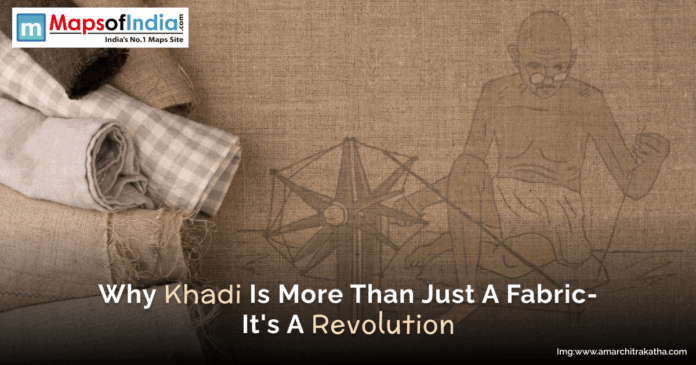Khadi is a hand-spun and hand-woven fabric of India. This is a living testament to the country’s spirit of resilience against the colonizer and creativity. Khadi is more than just a piece of fabric; it carries the weight of history with its cultural influence and a vision for a sustainable future. From its roots in the freedom struggle to its place on modern runways. Khadi tells a story of defiance of India’s craftsmanship and pride.
The Historical Roots of Khadi
Khadi, the hand-spun and hand-woven fabric, emerged as a cornerstone of India’s freedom struggle in the early 20th century. Supported by Mahatma Gandhi. Khadi became the symbol of the Swadeshi movement. This told Indians to boycott British textiles and embrace self-reliance. Gandhi’s 1918 call for khadi, which is documented in his writings, was aimed at empowering rural craftsmen and challenging colonial economic dominance. By 1920, the All India Khadi and Village Industries Board was established. This promotes cottage industries. Khadi’s significance lies in its defiance; each thread spun on a charkha was a quiet act of resistance against British rule. Fostering economic independence. Its coarse texture, made from cotton, silk, or wool, symbolized unity across India’s diverse regions. From Gujarat’s cotton khadi to Assam’s eri silk.
Khadi’s Cultural Significance
Beyond its political role during the freedom struggle, khadi embodies India’s cultural ethos. Khadi was worn by freedom fighters like Jawaharlal Nehru and Sardar Patel. It shows simplicity and solidarity with the masses. Today, Khadi has built a cultural bridge that connects urban fashion to rural traditions. Khadi has been featured in international festivals like Handloom Week. It has celebrated India’s artisanal heritage on a global stage. In regions like West Bengal, khadi sarees with intricate weaves are heirlooms and passed down through generations. Its versatility, used in kurtas, jackets, and home decor, reflects India’s blend of tradition and modernity. In recent times, social media has garnered more attention to this trend, making it well-known to everyone. This has amplified its cultural pride. Making it a symbol of national identity.
The Sustainable Edge
Khadi is a beacon of sustainability. Nowadays, the world is grappling with fast fashion, which is taking a toll on the environment. Khadi has nearly zero carbon footprint. This is the opposite of synthetic fabrics, which require energy-intensive production. According to a new study, khadi production uses 70% less water than conventional cotton textiles. Its biodegradable nature contrasts with polyester. This contributes to 3.5 million tons of India’s annual textile waste. The use of natural dyes in khadi production, like indigo and madder, helps to reduce chemical pollution. This aligns with global trends. Urban brands like Fabindia promote khadi as a green alternative to branded synthetic products.
Economic Empowerment
Khadi’s revival fuels economic empowerment for rural craftsmen. The Khadi and Village Industries Commission (KVIC) supports 15 lakh khadi craftsmen. And among those craftsmen 70% are women. By providing looms and training to craftsmen, KVIC has boosted khadi production by 25% since 2020. Which has generated ₹1,00,000 crore in sales. Artisans in villages like Sabarmati and Kutch earn ₹10000 to 20000 monthly. This is a significant rise from pre-existing incomes. Urban cafes and boutiques selling khadi products create direct markets and eliminate middlemen. Government schemes like the Solar Charkha Mission, which was launched in 2018, aim to employ 50000 more artisans by 2026. Increasing khadi’s role in rural economies.
Khadi in Modern Fashion
Khadi’s journey from rural traditions to global runways shows its demand and importance on the world stage. Global designers like Sabyasachi and Anavila Misra have reintroduced khadi in luxury fashion. They create sarees and jackets that mix heritage with contemporary aesthetics.
With the help of the government initiative, khadi products are being sold in local shops at affordable prices for common people. Khadi’s presence at the International Fashion trend has skyrocketed its sales. Its unique texture and lightweightness have appealed to the global market. The global handloom market, which is valued at $1.2 billion in 2025, has seen India’s khadi exports rise by 20%. Social media has amplified this trend. The e-commerce platform has seen a surge in khadi sales.
Challenges and Opportunities
Despite its resurgence in the local and global markets. Khadi has faced hurdles but also holds immense potential.
Challenges:
Competition from mass-produced products and the global market. Fast fashion brands, which offer clothes at 50% lower prices, challenge Khadi’s market share. The mass-produced clothes are way cheaper than the khadi clothes.
Skill decline in Khadi craftsmen. Only 10% of khadi artisans are under 30. This has the risk of knowledge loss. Young populations are moving to cities rather than continuing family traditions.
There is a large awareness gap. Most people are not aware of the benefits khadi clothes provide. They prioritize spending on global brands.
Opportunities:
Making the most of digital marketing. E-commerce platforms like Amazon Handmade have given a big opportunity to local craftsmen to reach the market without needing middlemen.
Youth Engagement. Skill India’s textile programs train 20000 youth each year.
Tourism Boost in craft villages like Bagh in Madhya Pradesh attracts 50000 tourists each year. Local governments or NGOs can promote khadi workshops. These show that Khadi’s can thrive with strategic support. Blending tradition with modern outreach can be one of the approaches.
The Future of Khadi
Khadi’s revolution has made a global impact. The help of Government initiatives like the Khadi Mark, which was introduced in 2013, has helped to ensure authenticity and boost consumer trust. The Ministry of Textiles aims to double khadi exports in the global market. Collaborations with international designers like Khadi collections at Paris Fashion Week 2024. Technology such as blockchain for supply chain transparency is being piloted by KVIC to trace khadi’s journey from loom to consumer. Social media campaigns. Inspire youth to embrace khadi as a lifestyle choice. As sustainable fashion grows. Khadi’s blend of heritage. Style positions it as a global icon.
Conclusion
Khadi is far more than a fabric. Khadi is a symbol of a revolution that has witnessed India’s past, present, and future. Born from the Swadeshi movement, it has become India’s cultural pride. It has a low environmental impact and promotes the economic empowerment of craftsmen. A study has shown its growing market with exports and digital sales soaring. There are challenges like competition and skill preservation. But there are opportunities through e-commerce. Government initiatives like youth training and tourism workshops can promise to bring a bright future. From rural traditions to urban fashion, khadi tells a story of resilience and reinvention. Showing that a simple cloth can spark a global movement for change.





